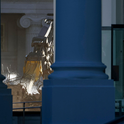President Trump may or may not be re-elected come November, but the US Supreme Court will continue, and—given its power to determine what the US Constitution ultimately means—remain crucially important. At present, the Supreme Court has four supposedly liberal members (appointed by democratic presidents) and five supposedly conservative—including Chief Justice John Roberts—and this usually, but not universally, affects case outcomes.
In recent months, however, despite its majority conservative make up, the court has delivered apparently progressive decisions in the fields of abortion and LGBTQ rights, and a high-profile rejection of Trump’s claim to absolute immunity from criminal proceedings. This has at the very least surprised people, and even led some to suggest the court has become a force for progressive values.
This is not an accurate picture. Other decisions, such as those on religion and voting rights, are more typical, and belie any liberal drift in the court, and even those decisions that appeared more expansive and liberal were very narrowly focused. A detailed look at recent cases reveals that this is still very much a conservative court.
The court term was much altered this spring/summer due to coronavirus. Oral arguments could not be held in open court but instead were conducted over the phone and broadcast live. Nonetheless, the court managed to deliver over 50 rulings, although only a handful can be discussed here. Regretfully, this omits noteworthy cases such as Chiafolo (where the court upheld “faithless elector” laws—i.e. those state laws punishing Electoral College members who do not vote for the presidential candidate chosen by their state’s voters) and McGirt v. Oklahoma (holding that much of eastern Oklahoma is a native American reservation).
But that still leaves some highly important, controversial cases. These rulings can be grouped according to four different types: those involving Trump himself and acts of the Trump administration; high-profile cases where LGBTQ and abortion rights are at issue; cases on religion; and those on voting rights.
Access to Trump’s tax returns
In its most recent ruling, on 9th July, the Supreme Court vigorously rejected Trump’s claim to absolute presidential immunity from any legal order to release his financial records. Unlike other recent presidents, Trump has refused to publish his tax returns. However, in Trump v Vance, the court ruled that Manhattan District Attorney Cyrus Vance can obtain them. Trump was swift to attack the court’s ruling, tweeting that this was a “political prosecution” and unfair to him. However, Chief Justice Roberts, writing for the 7:2 majority, held that Trump’s argument for immunity “runs up against the 200 years of precedent establishing that Presidents, and their official communications, are subject to judicial process.” Notably, Roberts and the four liberal justices were joined by the two Trump appointees, Neil Gorsuch and Brett Kavanaugh, in agreeing that “the president is neither absolutely immune from state criminal subpoenas seeking his private papers nor entitled to a heightened standard of need.”
It is certainly a relief that the court confirms that the president (who has said that he can do whatever he wants, commuted lawful sentences of personal friends and allowed tear gassing of peaceful protesters so he could be photographed with a bible) is not completely above the law. But even so, in a second case, it denied House of Representatives committees immediate access to similar documents. The public may not get sight of Trump’s tax returns before the election in November—the two cases were remitted back to lower courts to decide in accordance with the Supreme Court’s holding, and although those courts have scheduled early dates for hearings, litigation takes time.
Another high-profile decision, this time involving the administration rather than Trump personally, was Department of Homeland Security v. Regents of the University of California. The court held (5:4, in an opinion written by Roberts) that the government’s decision to terminate the DACA programme (which allowed “dreamers” —undocumented young people brought to the US as children—to apply for protection from deportation) violated procedural requirements for administrative agencies. The court found the DACA rescission to be an “arbitrary and capricious” violation of the law, lacking any meaningful justification. This decision provoked another angry tweet from Trump—complaining “we need NEW JUSTICES of the Supreme Court.” Yet, as Roberts wrote, “the dispute before the Court is not whether DHS may rescind DACA.” Indeed, he added, “all parties agree that it may.” And the department may well try again to do so. So perhaps this may be a Pyrrhic victory, and the “Dreamers” may yet be deported.
LGBTQ and abortion rights
Two further cases appeared surprising victories for liberals, and for that reason were condemned by many conservatives. But these rulings may not be so progressive as they first appear.
The Bostock and Harris Funeral Homes cases produced a 6:3 decision delivered by conservative Trump appointee, Gorsuch, hailed as the most significant ruling for LGBTQ rights since the 2015 Obergefell v. Hodges, where the court held state bans on same-sex marriages were unconstitutional. In Bostock and Harris, the court ruled that under Title VII of the 1964 Civil Rights Act, employment “discrimination based on homosexuality or transgender status necessarily entails [unlawful] discrimination based on sex.” The joined cases were brought by applicants fired for being homosexual or transgender. Gorsuch wrote that when these employees are dismissed , the employer “fires that person for traits or actions it would not have questioned in members of a different sex. Sex plays a necessary and undisguisable role in the decision, exactly what Title VII forbids.” In contrast, dissenting Justices Alito and Thomas argued that “there is only one word for what the Court has done today: legislation.” And yet, the decision was not so activist or radical—indeed, it could be seen as somewhat conservative, resting on a strong textualist basis. Gorsuch is a well-known textualist, believing judicial decisions must be based on what the law literally says, usually taken to be a conservative judicial approach. This may have been an important victory for LGBTQ rights, but it is a very narrow decision, unlikely to lead to further groundbreaking progress.
One should also highlight the narrowness of the June Medical Services decision, hailed as a significant win for abortion rights advocates. Here, the court ruled 5:4 that Louisiana's stringent restrictions on abortion violated the Constitution. The Louisiana statute required any doctor offering abortion services to have “admitting privileges” at a hospital within 30 miles. These admitting privileges were argued as necessary to provide a check on doctors’ credentials, but opponents argued they had little connection with medical competence, and that their enforcement would have left only one doctor at one single clinic for the 10,000 women seeking abortions in Louisiana every year. The opinion was authored by Justice Stephen Bryer (joined by all the court’s women justices) who found the Louisiana law “imposes an undue burden on a woman's constitutional right to choose to have an abortion.” However, the crucial fifth vote—which gave the court a majority to find the law unconstitutional—was provided by Roberts, who had previously voted against abortion access in the Supreme Court’s major rulings. Roberts wrote a separate opinion, based on very different reasons. He found the Louisiana law unconstitutional because it was “nearly identical” to the Texas law invalidated by the Supreme Court only four years before in Whole Woman’s Health v. Hellerstedt. He felt bound to respect the Texas ruling (although he had dissented in it) to abide by the rule of law and stare decisis, or precedent. He did, however, find many grounds of commonality with the four dissenters in June Medical Services. So this decision leaves plenty of room to uphold state laws that constrain abortion rights in different ways. And notably, in June Medical Services, there were four dissenting justices (including Kavanaugh, the Trump appointee whose confirmation in 2018 proved so controversial, but who asserted he was committed to stare decisis) willing to depart from a four-year-old precedent in an almost identical case, suggesting they might do so in other significant cases.
Religion
Further, the court recently delivered three opinions on religion—Little Sisters of the Poor; Our Lady of Guadalupe School; and Espinoza v. Montana—all upholding a broadly conservative approach to freedom of religion. (Notably, the court itself lacks religious diversity, with six Catholic and three Jewish members, but no Protestants, Muslims, atheists, or members of any other religion.) Little Sisters gained a lot of coverage outside the US, and the facts turned on religion, contraception and Obama’s Affordable Care Act, which exempted some religious groups from including contraception in their employees’ health insurance. In Little Sisters, the court endorsed the Trump administration’s much broader exception for employers who rely on religious objections to refuse contraception coverage. The majority (7:2) opinion held that the government must respect such religious beliefs and protect them. However, as a result of this ruling, many women must now pay extra for contraceptive coverage or go without access (according to the government’s own estimate, cited by Justice Ginsburg, between 70,500 and 126,400 women will immediately lose access). Although some saw the ruling as an important win for freedom of religion, Ginsburg wrote that “Today, for the first time, the court casts totally aside countervailing rights and interests in its zeal to secure religious rights to the nth degree.”
Voting rights
A further important case involves voting rights. In Merrill v. People First of Alabama, by a 5:4 ruling, the court blocked a lower court order easing voter restrictions in Alabama during the coronavirus pandemic. In Alabama, if a voter applies for a postal vote, the state requires a photo ID on application, and the signature of two witnesses or a notary when the ballot is returned. Those restrictions were challenged as placing an unlawful burden on the right to vote in light of the pandemic. But the court blocked the lower court decision in a brief order, giving no reasons. The court also made a similar order in Texas Democratic Party v. Abbott which involved a Texas law whereby only people over 65 (and statistically more likely to vote Republican) may obtain postal ballots. At the very least, this appears to be age discrimination violating the 26th Amendment.
These orders on voting rights could be seen as the most important Supreme Court rulings this term, given that participation in the electoral process is fundamental to the exercise of all other rights, and voter suppression undermines democracy. However, the Supreme Court has not shown any great sensitivity toward those seeking to protect their right to vote. Back in 2013, in Shelby County v. Holder, Roberts, writing for a 5:4 majority, invalidated a major section of the Federal Voting Rights Act, which had allowed the Justice Department to block changes to voting laws in states with a history of suppressing minority voters. Roberts believed that, contrary to the evidence assembled by Congress, the provision was no longer necessary because “our country has changed.” The recent killing of George Floyd, and Black Lives Matter movement, however, suggest the US has not changed so much. And the Shelby decision quickly led to many new state laws imposing more onerous voting ID requirements, limiting postal votes, gerrymandering and other measures. It is those laws which the Supreme Court seems hesitant to block today. The court recently also (again 5:4 along ideological lines) blocked the extension of voting in Wisconsin—in a decision that led to long lines of voters queueing at polling stations, and fear of infection in the pandemic. And of course, the Trump administration has attacked attempts to expand postal voting, arguing it is vulnerable to fraud, as well as expressing the concern that making it easier to vote could damage the party's chances. The upcoming presidential election may well turn on small margins of votes in a handful of contested states—so the stakes over voting rights are very high indeed, and Supreme Court decisions liable to play a crucial role.
*
What conclusions might one draw from this roundup? The current pivotal role played by Chief Justice Roberts in presenting the court to the public should be stressed. For example, he has been able to time publication of court opinions (starting with apparently liberal decisions, followed by a more conservative raft of opinions, and ending with the high-profile Trump tax returns) very astutely so as to share out decisions across different ideological divides. Still, some patterns are discernible.
President Trump was rebuked by the court for asserting unlimited presidential power—a significant decision upholding the rule of law, but the practical consequences remain to be seen. It might also seem that there were surprising victories for liberals, very often occurring where Roberts voted with the more liberal wing. Roberts added a crucial fifth vote both to prevent the federal government terminating the DACA programme, and to stop the court overturning a recent, major holding on abortion. He also joined the majority ruling that sex discrimination covers LGBTQ employees. Yet many other decisions have been more clearly conservative, such as those bolstering religion and voting rights cases.
Even the supposedly liberal victories should not be greeted too eagerly. Roberts added his fifth vote to the Louisiana abortion case to avoid overturning a recent precedent, not for any support of the substance of the holding itself. The LGBTQ case was decided on fairly narrow textual grounds. The “Dreamers” case turned on the Federal government ignoring administrative procedure, rather than any substantive rights of those at risk of deportation. All of these are narrowly decided, often pertaining to the small niceties of the instant case, not broadening individual rights more generally. Come November, even if a Democratic president is elected, the Supreme Court will still look pretty conservative.
Sionaidh Douglas-Scott is law and public affairs visiting fellow at Princeton University 2020-2021, and for 25 years co-taught a course on fundamental rights in the United States and Europe with former US Supreme Court Justice Anthony Kennedy
Has the US Supreme Court taken a liberal turn? Don’t count on it
Recent landmark cases are being too eagerly hailed as progressive victories
July 14, 2020

The US Supreme Court in Washington DC. Photo: CNP/SIPA USA/PA Images











